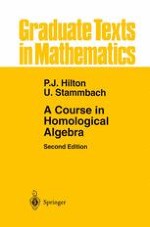1997 | OriginalPaper | Buchkapitel
The Künneth Formula
verfasst von : Peter J. Hilton, Urs Stammbach
Erschienen in: A Course in Homological Algebra
Verlag: Springer New York
Enthalten in: Professional Book Archive
Aktivieren Sie unsere intelligente Suche, um passende Fachinhalte oder Patente zu finden.
Wählen Sie Textabschnitte aus um mit Künstlicher Intelligenz passenden Patente zu finden. powered by
Markieren Sie Textabschnitte, um KI-gestützt weitere passende Inhalte zu finden. powered by
The Künneth formula has its historic origin in algebraic topology. Given two topological spaces X and Y, we may ask how the (singular) homology groups of their topological product X × Y is related to the homology groups of X and Y. This question may be answered by separating the problem into two parts. If C(X), C(Y) C(X × Y) stand for the singular chain complexes of X, Y, X × Y respectively, then a theorem due to Eilenberg-Zilber establishes that the chain complex C(X × Y) is canonically homotopy-equivalent to the tensor product of the chain complexes C(X) and C(Y), $$ C(X \times Y) \simeq C(X) \otimes C(Y) ; $$; (for the precise definition of the tensor product of two chain complexes, see Section 1, Example (a)). Thus the problem is reduced to the purely algebraic problem of relating the homology groups of the tensor product of C(X) and C(Y) to the homology groups of C(X) and C(Y). This relation is furnished by the Künneth formula, whose validity we establish under much more general circumstances than would be required by the topological situation. For, in that case, we are concerned with free chain complexes of ℤ-modules; the argument we give permits arbitrary chain complexes C, D of Λ-modules, where Λ is any p.i.d., provided only that one of C, D is flat. This generality allows us then to subsume under the same theory not only the Künneth formula in its original context but also another important result drawn from algebraic topology, the universal coefficient theorem in homology.
